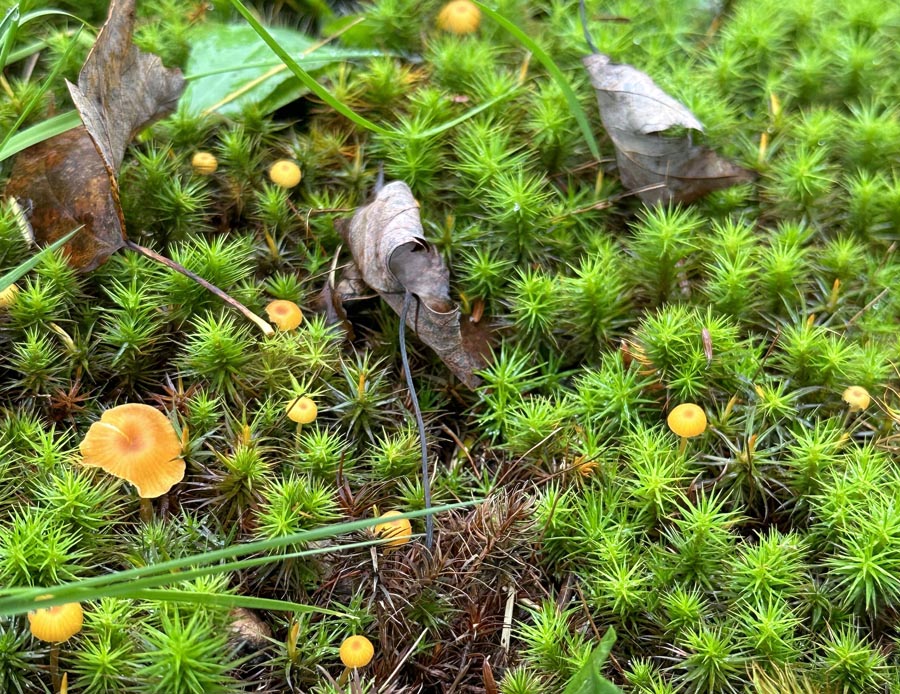The great Wood-wide Web: the trees in a forest interconnected by fungi. Fungal hyphae — the filamentous actual body of any fungus — running from tree to tree, sharing out sugars from the leaves of healthy trees, and giving water and essential nutrients in return. The forest one great Superorganism mediated by fungi. An enormously popular concept, and so very true: No Fungi? No future!
In all this it’s important to understand that fungi form associations with almost all life forms, not just trees: sometimes in a good way (most obviously as lichens or mycorrhizae) — and sometimes in not such a good way (for example, zombie ants and chestnut blight).
Fungi are now thought to have been essential for enabling rootless water dwelling plants to become established on land. They entered into ‘endophytic’ relationships with primitive plants, including mosses and liverworts — the closest modern relatives of the ancestors to the earliest terrestrial plants – – well before the evolution of trees and the trees and the Wood-wide web.
Many unrelated fungi are closely associated with mosses. The individual relationships may be saprobic (gaining carbon from dead plant material), or commensal (endophytic or parasitic) and obtaining carbon (sucrose) as the direct result of plant photosynthesis.
Here in Deering I have found, so far, two moss associated mushrooms: Cantharellula umbonata and Rickenella fibula. Both were associated with mosses in the genus Polytrichum., and I have found each only once.

Cantharellula umbonata
I wrote about Cantharellula umbonata, Greyling, in an earlier post. While the species is constantly associated with various mosses, I cannot find anything written about its trophic level, the nutritional nature of its relationship to the associated moss. When I collected it, I did not notice any obviously diseased areas of the patch of moss from which the mushroom arose. In this picture, on the right, one might see that the mushroom is attached to individual moss plants.


Rickenella fibula
I found Rickenella fibula, the Orange Moss Agaric, at home this fall in some of the extensive patches of Polytrichum moss that spreads in what we call ‘lawn.’ A whole herd of little yellow caps peering up at me from a bed of moss. These are little mushrooms that have small (2 – 10 mm across), orange or yellow orange caps with a depression in the center. The stem is delicate and lacks a ring. The gills are widely separated from each other and are white, they conspicuously run down the stem.
Rickenella fibula occurs late in the season, August to November in southern New Hampshire. It is widely distributed in North America and has been introduced into New Zealand. It is always associated with mosses, but not with any particular species.
The relationship of the species Rickenella fibula to moss is ambiguous, either parasitic/endophytic or mycorrhizal. The species has been shown to produce pegs, haustoria, within moss cells. These haustoria would presumably be absorbing nutrients from the moss and therefore are indicative of parasitism. A parasitic or endophytic trophic mode is supported by the fact that the some collections can produce enzymes that degrade plant cell walls. In a DNA analysis, a phylogenetic study, that included several collections all collections of R. fibula were biotrophic (mycorrhizal or parasitic/endophytic); none were saprotrophic (growing on dead plant material). However individual biotrophic collections clustered in the analysis with either mycorrhizal or parasitic/endophytic collections, the difference being how the respective groups access the sucrose produced by the moss through photosynthesis. As far as I can tell the Orange Moss Agaric that I found in my lawn does not seem to be adversely affecting its associated moss.

I am enjoying reading Gathering Moss , a nice little book by Robin Wall Kimmerer who wrote braiding sweetgrass. JTB >
LikeLike